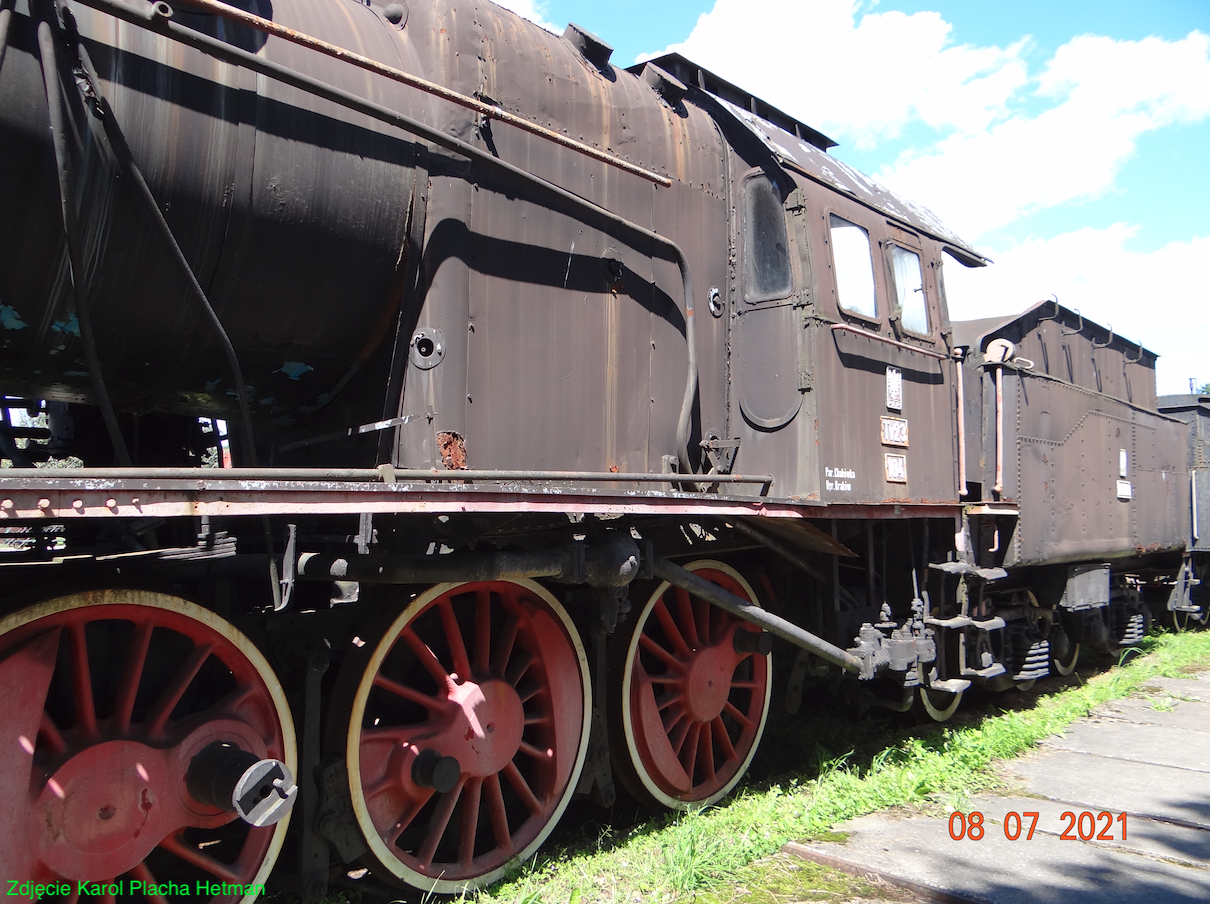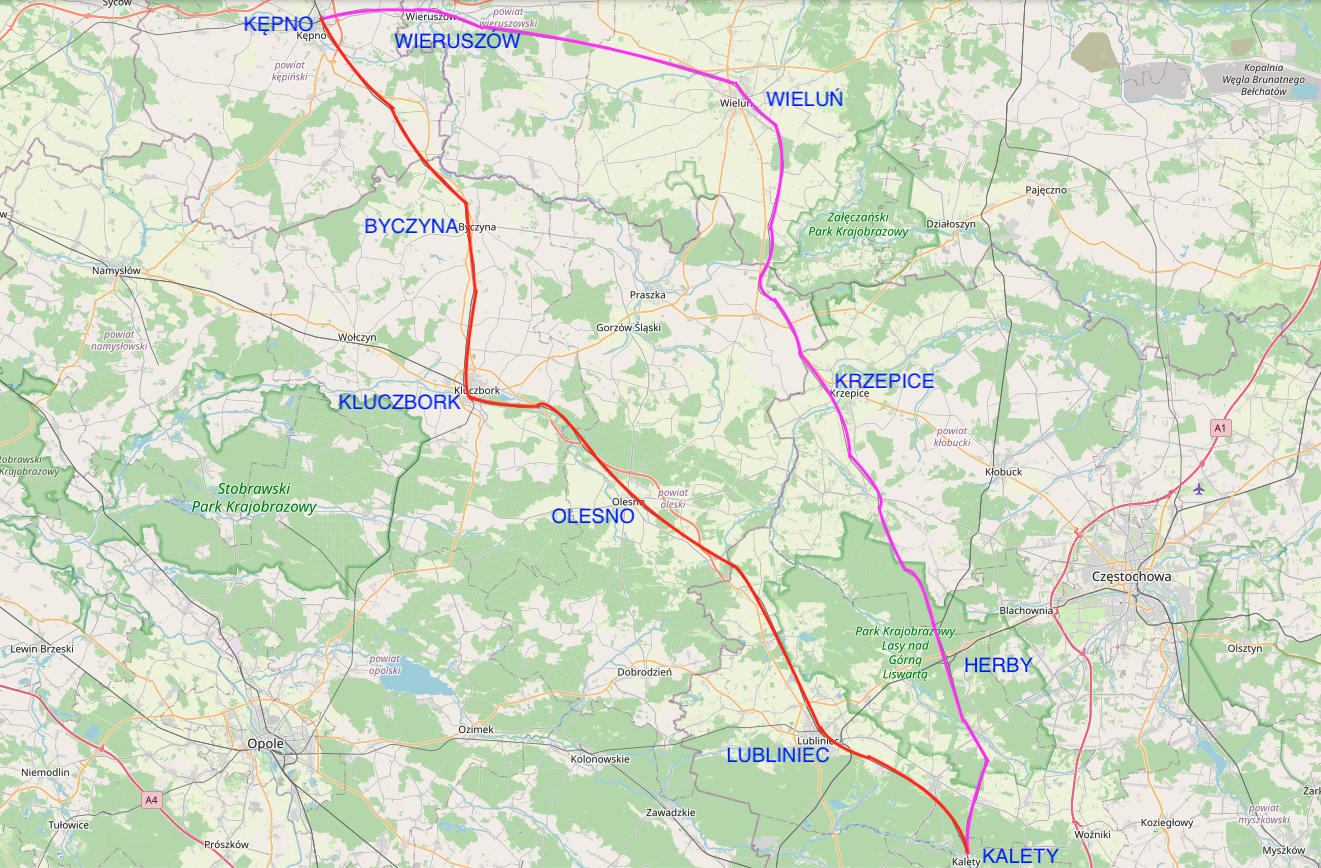Kalety 2023-08-19
PKP Coal trunk line, section Kalety - Kępno. 1926.
Geographic coordinates: 50.566N 18.888E.

Silesia - Gdynia coal main.
The Śląsk - Gdynia Coal Railway is colloquially called Węglówka. The route is the shortest railway route from the mines of Zagłębie Dąbrowskie to the seaport in Gdynia. It ensured the export of hard coal to other countries, mainly the Baltic Sea basin. It was the largest and most modern transport investment in the Second Polish Republic. The line was built thanks to the efforts of Poland and its then ally - France. It was built in the period 1926 - 1933.
Historical background.
In 1918, when Poland regained its independence, an important task was to combine the railway system into one efficient organism that would ensure the development of the country. At that time, an important commodity, apart from food, was hard coal, which Poland exported in large quantities. These exports provided significant revenue for the country's budget. The railway network inherited from the partitioning powers was inconsistent, unevenly developed and diversified in terms of technical equipment. There were different railway regulations on it. The routes taken over by the Germans and Austrians did not require large investments. It was worse with the rolling stock, which was handed over to us in the worst condition. The worst was with the routes taken over from Muscovites. They did not connect urban and industrial centers, only military facilities. The exception was the Warsaw - Vienna line. In addition, a wide track was used. There was little rolling stock, because the war was still going on in the Muscovite state.
Because the vital interests of Poland were different from those of the former partitioners, the existing railway lines changed their meaning. Many local lines gained economic importance for Poland. New directions have clearly formed; North South.
The construction of Gdynia was forced by the attitude of the authorities of the Free City of Gdańsk, whose Germanic inhabitants took advantage of imprecise provisions in the Treaty of Versailles. This did not give hope for free use of the railway route in Gdańsk, although it was operated by PKP.
Railway investments.
Already in 1921, the Gdynia - Kokoszki railway line was put into use, 26 km long, which bypassed Gdańsk. The line was built for military purposes. Due to the difficult terrain conditions, the line had sharp curves and steep ramps. This reduced the transport capacity on the line.
In the period 1920 - 1922, the Polish Army built the Swarzewo - Hel railway line, 44 km long, for military purposes. However, soon the line was also made available for public use.
In 1925, a customs war broke out with the Germans, who closed their routes for the transport of hard coal. The coal industry and the Polish economy were threatened by a crisis. Until now, hard coal was transported by two railway routes that ran through Gdańsk.
The first road, 567 km long, "Korytarz Kluczborski": Katowice - Chorzów - Tarnowskie Góry - Kalety - Lubliniec - Kluczbork - Kępno - Ostrów Wielkopolski - Jarocin - Września - Gniezno - Inowrocław - Bydgoszcz - Tczew - Gdańsk. Transport along this route was constantly hindered by the Germans in their area and high fees.
The second road, 666 km long: Katowice - Zawiercie - Częstochowa - Piotrków Trybunalski - Koluszki - Skierniewice - Łowicz - Kutno - Włocławek - Toruń - Bydgoszcz - Tczew - Gdańsk. Several new investments were made in the Łódź node, and above all, the construction of a new Zgierz - Kutno line, which increased the capacity of the route. There were 40 pairs of trains on the route during the day. Let us remember that river ports in Toruń, Bydgoszcz, Świecie and Tczew were also used for the export of hard coal.
The new line of Kaleta - Kępno.

On November 11, 1918, the great world war ended. The great of this world did not want to limit the German economy, and considered Poland to be a seasonal country. Only France supported Poland for its own interest. Poland was reborn from the territories annexed by Muscovites - Congress Poland and part of Galicia, after the collapse of Austria-Hungary. Greater Poland joined Poland after the victorious Greater Poland Uprising in February 1919 and Podzamcze (Wieruszów) returned to Poland. Kalety waited for its return to Poland until 1922, after winning the plebiscite, in a part of Upper Silesia. The right to use the "Krytbórz Corridor" was granted to Poland by the greats of this world. However, Poland had to pay a lot to the German railways for traveling along the Kluczbork Corridor.
In the south, the border station was Lubliniec, and on the German side there was the Ciasna station. In the north, the Germanic border station was Kostów, and on the Polish side, Łęka Opatowska station. Importantly, the new planned Polish route Kalety - Kępno was only 15 km longer than the "Korytarz Kluczborski".
The new route was of great importance for Poland. Its necessity was noticed by our politicians; Eugeniusz Kwiatkowski, Kazimierz Bartel and others. Also, all local governments supported its construction, seeing the possibilities of the region's development. However, there was no money for the investment. The outbreak of the customs war with the Germans on June 15, 1925 contributed to the announcement by the President of the Republic of Poland, Stanisław Wojciechowski, of an act authorizing the government to build a first-class standard-gauge railway line from the Kalety station through Herby, Wieluń to the Podzamcze station, with a length of about 122 km. The trail was built as part of the section Kalety - Wieluń - Opatówek - Inowrocław, 292 km long. The Wieluń station was supposed to be a junction station in the direction of Zduńska Wola.
The concession for the construction of the trail was granted to the Society of Engineering Works in Poznań, headed by Professor Stelmachowski, and the construction manager was Józef Nowkuński. The seat of the construction management was Lubliniec. Subcontractors were appointed through tenders. About 2,000 workers were employed. Work started in August 1925. The progress of the construction was observed by the family press. The construction site was visited by numerous delegations from Warsaw. Among others, Minister of Railway Kazimierz Tyszka.
The route under construction was single-track, but all engineering structures were prepared for a double-track route. Many embankments and excavations were already double track wide. 8 steel and 29 reinforced concrete bridges were built, as well as a viaduct on the Częstochowa - Lubliniec railway line. 65 heavy single turnouts, 15 light turnouts and one double turnout (at the Herby Nowe station) were installed. 138 road and rail crossings were also built. The works were carried out in accordance with the agreed schedule.
The following stations were built on the trail: Boronów, Herby Nowe, Kuleje, Panki, Krzepice, Janinów, Pontnów (now Pątnów Wieluński), Wieluń (now Wieluń Dąbrowa), and Czastary.
In the area of Herby Śląskie (since 1947, Herby Stare) a large railway junction was built, which connected the Częstochowa - Lubliniec railway line with a new route. On the new route, the Herby Nowe station was built, which is about 3 km away from the Herby Śląskie station. Branch posts were built. The new junction was and still is of great importance for the organization of railway traffic.
On the new line, rail traffic was launched on November 1, 1926. The ceremonial opening took place on November 6, 1926, in the presence of: Deputy Prime Minister Kazimierz Bartel, Minister of Industry and Trade Eugeniusz Kwiatkowski, Minister of Communications Paweł Romocki. The ceremony took place in Dzietrzniki. Currently there is a passenger stop here. The capacity of the trail has been confirmed; 10 pairs of freight trains and 3 pairs of passenger trains during the day. Already in November 1926, freight trains with hard coal ran. In 1927, shape exit signals were installed at all stations. Fast trains were launched at this time. The inhabitants of Wieluń and smaller railway stations gained a lot. First of all, convenient access to Katowice, Ostrów Wielkopolski, Poznań, and good work on the railway. The construction of the route contributed to the expansion of the Tarnowskie Góry station, which over time became the largest freight station in Poland and one of the largest in Europe.
In 1928, the railway traffic on the Kalety - Herby Stare section increased significantly. During this period, 28 pairs of trains ran daily. Already in 1929, on this section (Kalety - Herby Nowe) the second track was put into operation. The Herby Nowe - Wieruszów route remained single-track, although there were plans to build a second track by 1940.
Modern Polish Ty23 steam locomotives with trains weighing 2,000 tons ran along the entire route. The travel time of the hard coal train on the route Katowice - Gdynia was 48 hours.
On November 28, 1965, the Kalety - Herby Nowe section was electrified, and on October 24, 1981, the further part was electrified: Krzepice, Wieluń, Wieruszów to Kępno.
In 1973, as a result of administrative changes, the Pozamcze station was renamed Wieruszów. In 1986, the Wieruszów Miasto passenger stop was launched.
Written by Karol Placha Hetman
